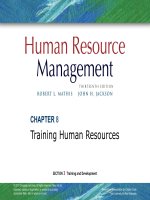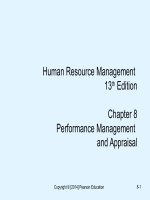Operation management 10e heizer render chapter 08
Bạn đang xem bản rút gọn của tài liệu. Xem và tải ngay bản đầy đủ của tài liệu tại đây (756.65 KB, 46 trang )
Operations
Management
Chapter 8 –
Location Strategies
PowerPoint presentation to accompany
Heizer/Render
Principles of Operations Management, 7e
Operations Management, 9e
© 2008 Prentice Hall, Inc.
8–1
Outline
Global Company Profile:
FedEx
The Strategic Importance of
Location
© 2008 Prentice Hall, Inc.
8–2
Outline – Continued
Factors That Affect Location
Decisions
Labor Productivity
Exchange Rates and Currency Risks
Costs
Political Risk, Values, and Culture
Proximity to Markets
Proximity to Suppliers
Proximity to Competitors (Clustering)
© 2008 Prentice Hall, Inc.
8–3
Outline – Continued
Methods of Evaluating Location
Alternatives
The Factor-Rating Method
Locational Break-Even Analysis
Center-of-Gravity Method
Transportation Model
© 2008 Prentice Hall, Inc.
8–4
Outline – Continued
Service Location Strategy
How Hotel Chains Select Sites
The Call Center Industry
Geographic Information Systems
© 2008 Prentice Hall, Inc.
8–5
Learning Objectives
When you complete this chapter you
should be able to:
1. Identify and explain seven major factors
that effect location decisions
2. Compute labor productivity
3. Apply the factor-rating method
4. Complete a locational break-even
analysis graphically and mathematically
5. Use the center-of-gravity method
© 2008 Prentice Hall, Inc.
8–6
Federal Express
Central hub concept
Enables service to more locations with
fewer aircraft
Enables matching of aircraft flights with
package loads
Reduces mishandling and delay in transit
because there is total control of
packages from pickup to delivery
© 2008 Prentice Hall, Inc.
8–7
Location Strategy
One of the most important decisions a
firm makes
Increasingly global in nature
Significant impact on fixed and
variable costs
Decisions made relatively infrequently
The objective is to maximize the
benefit of location to the firm
© 2008 Prentice Hall, Inc.
8–8
Location and Costs
Location decisions based on low
cost require careful consideration
Once in place, location-related
costs are fixed in place and
difficult to reduce
Determining optimal facility
location is a god investment
© 2008 Prentice Hall, Inc.
8–9
Location and Innovation
Cost is not always the most important
aspect of a strategic decision
Four key attributes when strategy is
based on innovation
High-quality and specialized inputs
An environment that encourages
investment and local rivalry
A sophisticated local market
Local presence of related and
supporting industries
© 2008 Prentice Hall, Inc.
8 – 10
Location Decisions
Long-term decisions
Decisions made infrequently
Decision greatly affects both fixed
and variable costs
Once committed to a location,
many resource and cost issues
are difficult to change
© 2008 Prentice Hall, Inc.
8 – 11
Location Decisions
Country Decision
Figure 8.1
© 2008 Prentice Hall, Inc.
Critical Success Factors
1. Political risks, government
rules, attitudes, incentives
2. Cultural and economic
issues
3. Location of markets
4. Labor talent, attitudes,
productivity, costs
5. Availability of supplies,
communications, energy
6. Exchange rates and
currency risks
8 – 12
Location Decisions
Region/
Community
Decision
MN
WI
MI
IL
IN
OH
Critical Success Factors
1.
2.
3.
4.
5.
6.
7.
Figure 8.1
© 2008 Prentice Hall, Inc.
8.
Corporate desires
Attractiveness of region
Labor availability, costs,
attitudes towards unions
Costs and availability of utilities
Environmental regulations
Government incentives and
fiscal policies
Proximity to raw materials and
customers
Land/construction costs
8 – 13
Location Decisions
Site Decision
Critical Success Factors
1. Site size and cost
2. Air, rail, highway, and
waterway systems
3. Zoning restrictions
4. Proximity of services/
supplies needed
5. Environmental impact
issues
Figure 8.1
© 2008 Prentice Hall, Inc.
8 – 14
Growth Competitiveness
Index of Countries
Country
Switzerland
USA
Japan
Germany
UK
Israel
Canada
New Zealand
Italy
China
Mexico
Russia
© 2008 Prentice Hall, Inc.
2006-2007 Rank
1
6
7
8
10
15
16
23
42
54
58
62
2005 Rank
4
1
10
6
9
23
13
22
38
48
59
Table 8.1
53
8 – 15
Factors That Affect
Location Decisions
Labor productivity
Wage rates are not the only cost
Lower production may increase total cost
Labor cost per day
= Cost per unit
Production (units per day)
Connecticut
Juarez
$70
= $1.17 per unit
60 units
$25
= $1.25 per unit
20 units
© 2008 Prentice Hall, Inc.
8 – 16
Factors That Affect
Location Decisions
Exchange rates and currency risks
Can have a significant impact on cost
structure
Rates change over time
Costs
Tangible - easily measured costs such as
utilities, labor, materials, taxes
Intangible - less easy to quantify and
include education, public transportation,
community, quality-of-life
© 2008 Prentice Hall, Inc.
8 – 17
Factors That Affect
Location Decisions
Exchange rates and currency risks
Can have a significant impact on cost
Location
structure
decisions
based
Rates change over
time
on costs alone
Costs
can create
Tangible - easily measured costs such as
difficult ethical
utilities, labor, materials, taxes
situations
Intangible - less easy to quantify and
include education, public transportation,
community, quality-of-life
© 2008 Prentice Hall, Inc.
8 – 18
Factors That Affect
Location Decisions
Political risk, values, and culture
National, state, local governments
attitudes toward private and intellectual
property, zoning, pollution, employment
stability may be in flux
Worker attitudes towards turnover, unions,
absenteeism
Globally cultures have different attitudes
towards punctuality, legal, and ethical
issues
© 2008 Prentice Hall, Inc.
8 – 19
Ranking Corruption
Rank
1
1
1
5
7
11
14
15
16
17
20
34
70
121
Country
2006 CPI Score (out of 10)
Finland
9.6
Least
Corrupt
Iceland
9.6
New Zealand
9.6
Singapore
9.4
Switzerland
9.1
UK
8.6
Canada
8.5
Hong Kong
8.3
Germany
8.0
Japan
7.6
USA, Belgium
7.3
Israel, Taiwan
5.9
Most
Brazil, China, Mexico
3.3
Corrupt
Russia
2.5
Table 8.2
© 2008 Prentice Hall, Inc.
8 – 20
Factors That Affect
Location Decisions
Proximity to markets
Very important to services
JIT systems or high transportation costs
may make it important to manufacturers
Proximity to suppliers
Perishable goods, high transportation
costs, bulky products
© 2008 Prentice Hall, Inc.
8 – 21
Factors That Affect
Location Decisions
Proximity to competitors
Called clustering
Often driven by resources such as natural,
information, capital, talent
Found in both manufacturing and service
industries
© 2008 Prentice Hall, Inc.
8 – 22
Clustering of Companies
Industry
Locations
Reason for clustering
Wine making
Napa Valley (US)
Bordeaux region
(France)
Natural resources of
land and climate
Software firms
Silicon Valley,
Boston, Bangalore
(India)
Talent resources of
bright graduates in
scientific/technical
areas, venture
capitalists nearby
Race car
builders
Huntington/North
Hampton region
(England)
Critical mass of talent
and information
© 2008 Prentice Hall, Inc.
Table 8.3
8 – 23
Clustering of Companies
Industry
Locations
Reason for clustering
Theme parks
(Disney World,
Universal
Studios)
Orlando, Florida
A hot spot for
entertainment, warm
weather, tourists, and
inexpensive labor
Electronics
firms
Northern Mexico
NAFTA, duty free
export to US
Computer
hardware
manufacturers
Singapore, Taiwan
High technological
penetration rate and
per capita GDP,
skilled/educated
workforce with large
pool of engineers
© 2008 Prentice Hall, Inc.
Table 8.3
8 – 24
Clustering of Companies
Industry
Locations
Reason for clustering
Fast food
chains
(Wendy’s,
McDonald’s,
Burger King,
and Pizza Hut)
Sites within 1 mile
of each other
Stimulate food sales,
high traffic flows
General
Wichita, Kansas
aviation aircraft
(Cessna,
Learjet, Boeing)
Mass of aviation skills
Orthopedic
devices
Ready supply of skilled
workers, strong U.S.
market
© 2008 Prentice Hall, Inc.
Warsaw, Indiana
Table 8.3
8 – 25









